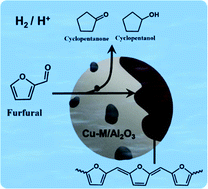Nature of polymeric condensates during furfural rearrangement to cyclopentanone and cyclopentanol over Cu-based catalysts†
Abstract
Catalyst deactivation and carbon loss are frequently encountered problems in furfural conversion in the aqueous phase. Although several mechanisms were proposed, an in-depth experimental study on the spent catalysts and condensates formed on catalyst surfaces is essential for the development of catalysts with high resistance to condensation. A series of Cu catalysts with various alkali or alkaline earth metal additives was synthesized and tested for furfural conversion to cyclopentanone and cyclopentanol. The addition of alkali or alkaline earth metals significantly inhibited the condensate formation, likely due to the stabilization effect of the important carbocation intermediate. Characterization techniques including FT-IR, XRD, thermogravimetric analysis, and pyrolysis GC-MS were used to analyze the spent catalysts. The results revealed that the condensates formed on the catalyst surface were highly conjugated polymers resulting from the polymerization of furfuryl alcohol. The conclusions of this research are applicable to other furfural hydroconversions in the aqueous phase in acidic or neutral environments.



 Please wait while we load your content...
Please wait while we load your content...